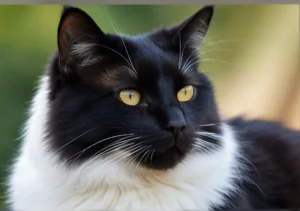Have you ever wondered why cats have long whiskers? Delve into the fascinating world of feline anatomy as we uncover the reasons behind this unique trait.
The Purpose of Whiskers
Have you ever noticed how a cat’s whiskers are much longer and stiffer than their fur? These specialized hairs, known as vibrissae, serve a crucial purpose in a cat’s daily life. Whiskers act as an essential tool for navigation, helping cats sense the size, shape, and even the texture of objects in their environment. They are so sensitive that they can detect even the slightest changes in air currents, alerting the cat to potential obstacles. So, next time you see a cat delicately brushing against furniture, remember that they are using their whiskers to map out their surroundings.
Whiskers as Sensory Organs
Beyond aiding in navigation, a cat’s whiskers also act as remarkable sensory organs. These specialized hairs are deeply rooted in a cat’s facial muscles and are connected to an extensive network of nerves. This unique setup allows whiskers to pick up on sensory information with incredible precision. In fact, a cat can determine the size of an opening by simply brushing their whiskers against it. This level of sensitivity helps cats move through their surroundings with grace and confidence, making them formidable hunters and agile companions.
- Extra Tip: Never trim or cut a cat’s whiskers. Doing so can disorient them and make them feel anxious. Whiskers are not just aesthetic features but essential tools for a cat’s well-being.
Whisker Growth and Shedding
Cats’ whiskers, also known as vibrissae, are crucial sensory tools that help them navigate their surroundings. These long, thick hairs are deeply rooted in specialized follicles that are surrounded by sensitive nerves, making them incredibly sensitive to even the slightest touch or movement. Whiskers grow to be as long as the cat’s body is wide, allowing them to accurately measure gaps and assess whether they can fit through tight spaces without getting stuck.
As cats explore, hunt, or play, their whiskers act as a highly sophisticated radar system, providing essential information about their environment. Whisker growth is a continuous process, with old whiskers shedding, and new ones growing in their place to ensure optimal functionality. Shedding whiskers can indicate stress in cats, so it’s essential to monitor the health and well-being of your feline friend if you notice excessive whisker loss.
Whiskers in Different Cat Breeds
While whiskers serve the same purpose across all cat breeds, their length can vary significantly based on genetics and breed characteristics. Certain breeds, such as the Maine Coon and the Siberian, are known for their particularly long whiskers, which can extend far beyond their faces. These lengthy whiskers enhance their already impressive hunting skills and agility.
On the other hand, some breeds, like the Siamese or the Burmese, may have shorter whiskers compared to their larger counterparts. Genetics play a crucial role in determining whisker length, with some breeds naturally predisposed to shorter or longer vibrissae. Keep in mind that regardless of their length, whiskers are vital tools for all cats to navigate their world effectively.
Additional Insight:
Fun Fact: Whiskers can also indicate a cat’s mood or emotions. When a cat is relaxed and content, their whiskers will point forward, while a frightened or defensive cat may press their whiskers flat against their face. Observing your cat’s whiskers can provide valuable insights into their emotional state and well-being.
Fun Facts About Cat Whiskers
Cat whiskers are not just cute accessories – they serve a vital purpose in helping cats navigate their surroundings. These long, sensitive hairs are actually touch receptors, providing valuable information about the environment to the cat. They can sense even the slightest changes in air currents, helping a cat determine the size and shape of objects around them.
Did you know that cat whiskers can also signal a cat’s mood and emotions? When a cat is feeling content and relaxed, their whiskers are usually positioned forward. But if they are feeling scared or threatened, the whiskers will be pulled back close to their face. So, next time you see a cat’s whiskers twitching, pay attention – they might be trying to tell you something!
Whiskers and Hunting Instincts
Cat whiskers are not just there for looks – they are essential for a cat’s survival instincts, especially when it comes to hunting. These whiskers are incredibly sensitive, allowing cats to detect even the tiniest movements of their prey. This precision helps cats pounce with accuracy and agility, making them formidable hunters in the wild.
In fact, the length of a cat’s whiskers is roughly equal to the width of their body, helping them gauge whether they can fit through tight spaces or catch their prey without getting stuck. So, next time you see a cat stalking a bird or a mouse, remember that those whiskers are playing a crucial role in their hunting strategy.
Bonus Tip: To help your indoor cat satisfy their natural hunting instincts, consider providing interactive toys that mimic prey movements. This not only provides mental stimulation but also allows your cat to engage their hunting instincts in a safe environment.
The Importance of Not Trimming Whiskers
Have you ever wondered why cats have such long whiskers? These incredible sensory tools are not just for show; they play a vital role in helping cats navigate their environment.
Whiskers are filled with sensitive nerve endings that help cats detect even the slightest changes in their surroundings. By brushing against objects, whiskers provide valuable information about the size, shape, and texture of their surroundings, helping cats move with grace and precision.
It is crucial never to trim a cat’s whiskers, as this can severely impair their ability to sense their environment. Trimming whiskers can lead to disorientation, increased stress, and even safety hazards for your feline friend. Cats rely on their whiskers to assess whether they can fit through a narrow space, detect potential predators, or even judge the distance when leaping.
Respect your cat’s whiskers as a vital sensory organ and avoid the temptation to trim them. By allowing your cat’s whiskers to remain long and intact, you are helping them thrive in their environment and stay safe and secure.
Tips for Cat Whisker Care
Let’s dive into some tips for ensuring your cat’s whiskers remain healthy and vibrant.
Avoid using narrow food and water dishes : Cats’ whiskers are quite long, so make sure to provide them with wide, shallow dishes to prevent their whiskers from being squished against the sides, causing discomfort.
Regular Gentle Cleaning : Cats are pretty good at grooming themselves, but a gentle swipe with a soft cloth to clean any food or debris stuck in their whiskers will keep them happy and healthy.
Provide Mental Stimulation : Engage your cat in interactive play and puzzle toys to keep their senses sharp and their whiskers working to their full potential.
Regular Vet Check-ups : During routine vet visits, ensure your vet checks your cat’s whiskers as well. Sometimes whisker issues can be a sign of an underlying health problem.
Proper Nutrition : A well-balanced diet helps maintain healthy whiskers, so make sure your cat’s food provides all the necessary nutrients for overall well-being.
By implementing these simple tips, you can ensure that your cat’s whiskers remain in top condition, allowing them to navigate their world comfortably and confidently.
Alex, a passionate animal lover, has experience in training and understanding animal behavior. As a proud pet parent to two dogs and three cats, he founded AnimalReport.net to share insights from animal experts and expand his knowledge of the animal kingdom.




